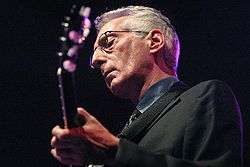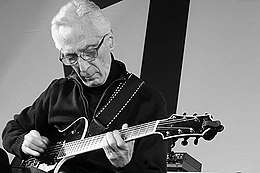Pat Martino
| Pat Martino | |
|---|---|
 | |
| Background information | |
| Birth name | Pat Azzara |
| Born |
August 25, 1944 Philadelphia, Pennsylvania, U.S. |
| Genres | Jazz fusion, mainstream jazz, soul jazz |
| Occupation(s) | Musician |
| Instruments | Guitar |
| Years active | 1959–present |
| Labels | Vanguard, Prestige, Warner Bros, Muse, Columbia, King, Paddlewheel, Evidence, Sony, 32 Jazz, HighNote, Milestone, Polydor, Concord, Fantasy, House of Blues, Mythos, Mainstream, Cobblestone, Atlantic, Blue Note |
| Website |
patmartino |
Pat Martino (born August 25, 1944) is a jazz guitarist and composer within the post-bop, fusion, mainstream jazz and soul jazz idioms. He is noted for his mathematical approach to the instrument (he has released textbooks such as Linear Expressions) and advanced knowledge of music theory.
Biography
Martino was born Pat Azzara in South Philadelphia. He began playing professionally at the age of 15 after moving to New York City. He lived for a period with Les Paul and began playing at jazz clubs such as Smalls Paradise. He later moved into a suite in the President Hotel on 48th Street. He would play at Smalls for six months of the year, and then in the summer play at the Club Harlem in Atlantic City.[1]
Martino played and recorded early in his career with Lloyd Price, Willis Jackson, and Eric Kloss. He also worked with jazz organists Charles Earland, Richard "Groove" Holmes, Jack McDuff, Don Patterson, Trudy Pitts, Jimmy Smith, Gene Ludwig, Bobby Pierce, and Joey DeFrancesco.
Martino had been performing until an aneurysm in 1980 left him with amnesia and no recollection or knowledge of his career or how to play the very instrument that made him successful. Martino says he came out of surgery with complete forgetfulness, learning to focus on the present instead of the past or what may lie ahead. He was forced to learn how to play the guitar from zero. This circumstance is crucial to understand his career and his particular way of thinking.[2][3]
Martino is married to Ayako Asahi Martino, whom he met in Tokyo, Japan, in 1995.[4]
He was chosen as Guitar Player of the Year in the Down Beat magazine Readers' Poll of 2004. In 2006, Mobile Fidelity Sound Lab reissued his album East! on Ultradisc UHR SACD.
In 2017, he shot a series of videos entitled "A Study of the Opposites and How They Manifest on the Guitar" for TAGAPublishing.com where he teaches students how to play jazz guitar.[5]
Musical approach
Martino states, "There are elements within an instrument’s architecture that initiate a continuous source of valuable information. For the guitar, there are two. The first is the major third interval, and the second is the minor third interval. Once we view their repetitive information, they begin to appear as a series of automatic functions."[6]
Martino's lines contain chromatic links outside any particular IIm7 chord that might be conceptualized over a chord progression, even in the examples he provides in his books and instructional videos. On his bulletin board he has stated that he formulated the system more as a way to explain his playing rather than as something to use to create music. In his own words, "although the analysis of some of my recorded solos have been referred to as modal, personally I've never operated in that way. I've always depended upon my own melodic instinct, instead of scale like formulas."[7]
Awards and honors

- 1995 Mellon Jazz Festival dedicated in honor[8]
- 1996 Philadelphia Alliance Walk of Fame Award[9]
- 1997 National Academy of Recording Arts & Sciences Songs from the Heart Award[10]
- 2002 Grammy Award nominations for Best Jazz Instrumental Album, Live at Yoshi's, and Best Jazz Instrumental Solo on "All Blues"[11]
- 2002 National Academy of Recording Arts & Sciences 2nd Annual Heroes Award[12]
- 2003 Grammy nominations for Best Jazz Instrumental Album, Think Tank, and Best Jazz Instrumental Solo on "Africa"[13]
- 2004 Guitar Player of the Year, DownBeat Magazine's 2004 Readers' Poll [14]
- 2016 Pennsylvania State Senator Vincent Hughes and his wife Sheryl Lee Ralph-Hughes presented Pat Martino with the Jazz Legacy Award[15]
Discography
As leader
|
As sideman
|
Bibliography
- Martino, Pat; Milkowski, Bill (2011). Here and Now! The Autobiography of Pat Martino. Backbeat Books. ISBN 978-1617130274.
References
- ↑ Spatz, David (October 11, 2017). "Jazz festival to bring legends like Pat Martino to Somers Point". The Press of Atlantic City.
- ↑ Gallagher, Brian (January 8, 2015). "Brain Damage Saved His Music". Nautilus. ISSN 2372-1766.
- ↑ "Jazz Guitar After Brain Damage". Discover. October 6, 2013. ISSN 0274-7529.
- ↑ Brady, Shaun (August 2008). "Pat Martino". Jazz Times. Retrieved April 11, 2016.
- ↑ Media, ALH. "Pat Martino: A Study of the Opposites and How They Manifest on the Guitar - TAGA Publishing". tagapublishing.com. Retrieved 2018-03-09.
- ↑ Martino, Pat (15 February 2011). "Inside Jazz: Augmented and Diminished Forms". Premier Guitar. Retrieved 21 November 2017.
- ↑ "Jazz Bulletin Board – View Single Post – Pat Martino". Forums.allaboutjazz.com. January 29, 2010. Archived from the original on March 7, 2012. Retrieved February 19, 2013.
- ↑ "Pat Martino Trio". Jazz Alley. Retrieved March 8, 2018.
- ↑ "Biography".
- ↑ "Jazz Great Pat Martino to play Two Nights at Chris' Jazz Cafe".
- ↑ "Complete List Of Grammy Nominees".
- ↑ "Pat Martino Organ Trio featuring Pat Bianchi and Carmen Intorre Jr".
- ↑ "Grammy Award Winners". The New York Times. Associated Press.
- ↑ Schoof, Dustin (May 15, 2014). "Pat Martino discusses relearning to play guitar after a near-fatal brain aneurysm left him with amnesia". The Express-Times.
- ↑ "Jazz Legacy Awards honors Northwest Philadelphia jazz artists".
- ↑ Taylor, Derek (February 13, 2014). "Review of Young Guns". DustedMagazine.
External links
- Official website
- Pat Martino at AllMusic
- Pat Martino discography
- Martino Unstrung documentary about Martino